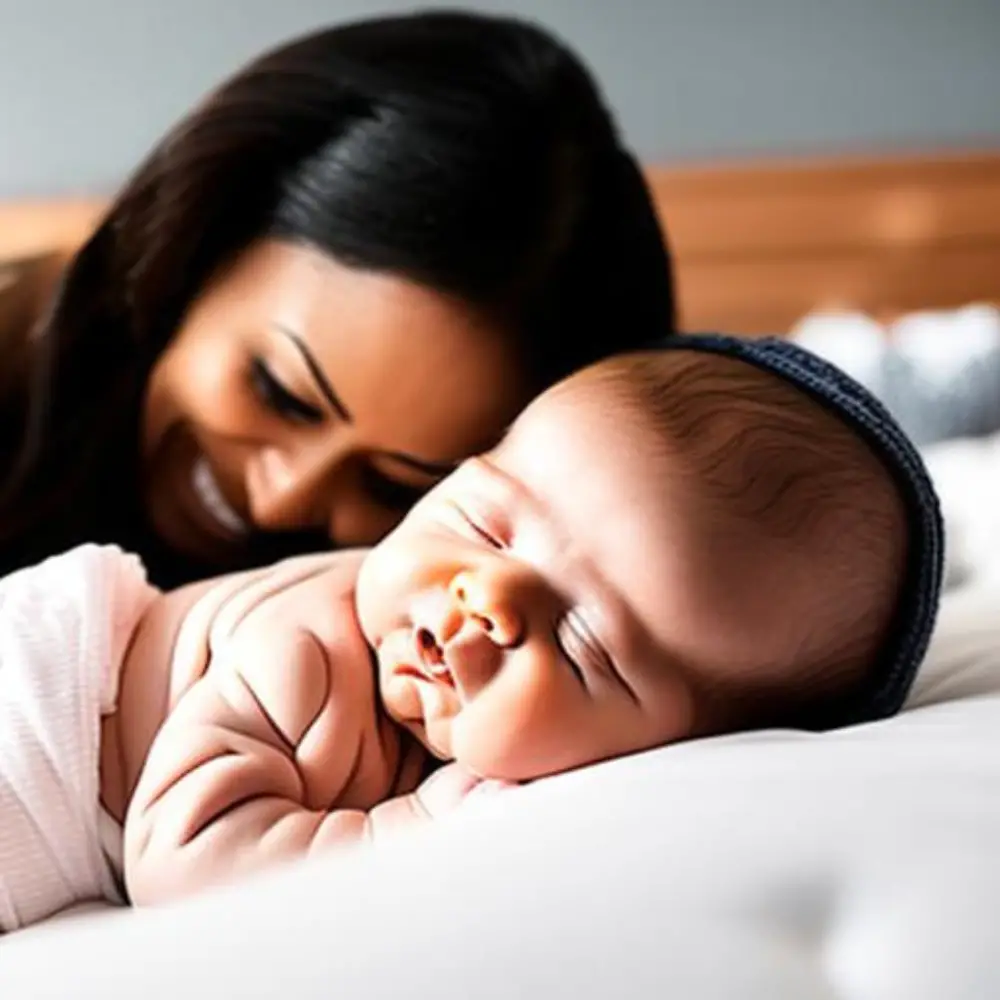How To Sleep Train After Co-Sleeping
Co-sleeping, or the practice of sharing a sleep surface with a baby or child, is a topic of much debate among parents and healthcare professionals. While some parents swear by the benefits of co-sleeping, others are concerned about the potential risks, such as Sudden Infant Death Syndrome (SIDS) and suffocation. I personally am not a fan of it.
Tips On Sleep Training
In this article, we will explore the pros and cons of co-sleeping, and provide answers to some frequently asked questions. Our goal is to provide parents with the information they need to make an informed decision about co-sleeping, while also promoting safe sleep practices for babies and young children.
Create a Comfortable Sleeping Environment
One of the first steps in transitioning your baby to independent sleep is to create a comfortable sleeping environment. This means setting up a safe and comfortable bed with a firm mattress, breathable bedding, and a temperature-controlled room. Use a white noise machine to help drown out outside noises and create a soothing atmosphere for sleep.
Establish a Consistent Bedtime Routine
Establishing a consistent bedtime routine can help signal to your baby that it’s time to wind down and prepare for sleep. This routine should include calming activities such as a warm bath, reading a book, or singing a lullaby. Be consistent with your routine, so your baby knows what to expect each night.
Start with Naps
It can be helpful to start the transition to independent sleep by having your baby take naps in their own sleeping space. This can help them get used to their new sleeping space gradually. Be sure to provide plenty of reassurance and comfort during these naps, so your baby feels secure and safe.
Gradually Move Away
When you put your baby to bed at night, start by lying down next to them until they fall asleep. Over time, gradually move further away from the bed until you’re outside the room. This can help your baby feel more secure and get used to sleeping on their own.
Be Consistent
Consistency is key when it comes to sleep training. Stick to the same bedtime routine, and respond to your baby’s needs in a consistent manner. If they wake up during the night, reassure them with a soothing voice and try to encourage them to fall back asleep on their own.
Be Patient
Remember that this process can take time, and your baby may resist the change. Be patient and persistent, and eventually, your baby will learn to fall asleep independently.
Seek Support
If you’re struggling with the transition, seek support from a healthcare provider, a sleep consultant, or other parents who have gone through the same process. It’s important to have a support system in place to help you navigate this challenging time.
Consider Your Own Needs
As you transition to independent sleep, it’s important to consider your own needs as well. Make sure you’re getting enough rest, and take time to practice self-care. Remember that a well-rested parent is better able to care for their baby.
Monitor Your Baby’s Sleep
As you transition from co-sleeping to independent sleep, it’s important to monitor your baby’s sleep and make sure they’re getting enough rest. Keep track of how long they sleep and how often they wake up during the night and talk to your healthcare provider if you have concerns.
Be Prepared for Setbacks
Even after your baby has successfully transitioned to independent sleep, there may be setbacks along the way. Teething, illness, or changes in routine can all disrupt your baby’s sleep, so it’s important to be prepared for these challenges and to have a plan in place to help your baby adjust.
Transitioning from co-sleeping to independent sleep can be a challenging process, but with patience, consistency, and a positive attitude, you can help your baby learn to fall asleep and stay asleep on their own. Remember to create a comfortable sleeping environment, establish a consistent bedtime routine,
Is It Safe To Co-Sleep?
Co-sleeping, or sleeping in the same bed with your baby, can be a controversial topic. Some parents and experts believe that it can be a safe and beneficial practice, while others warn of the potential risks. Personally, I don’t think it is a good thing to do. I just don’t think it is worth the risk.
Proponents of co-sleeping argue that it can promote bonding and emotional security between parents and babies, improve sleep quality for both, and facilitate breastfeeding. They also point out that co-sleeping has been a common practice in many cultures throughout history and around the world.
However, opponents of co-sleeping warn of the potential risks, including accidental suffocation, entrapment, and Sudden Infant Death Syndrome (SIDS). The American Academy of Pediatrics (AAP) recommends against bed-sharing with infants, citing these risks.
It’s important to note that there are different types of co-sleeping, and the safety risks can vary depending on the specific circumstances. For example, bed-sharing, where the baby sleeps in the same bed with the parents, is considered a lot riskier than room-sharing, where the baby sleeps in a separate crib or bassinet in the same room as the parents.
If you choose to co-sleep, there are steps you can take to minimize the risks:
- Use a firm mattress and avoid soft surfaces such as couches or waterbeds.
- Keep soft bedding, such as blankets and pillows, away from the baby.
- Avoid alcohol and drug use before bed, as they can impair your ability to wake up if the baby is in distress.
- Do not co-sleep if you or your partner smokes, as this increases the risk of SIDS.
- Use a co-sleeper or sidecar crib that attaches to the side of the bed, providing a separate sleeping space for the baby while still allowing for close proximity to the parents.
The decision of whether or not to co-sleep is a personal one, and parents should carefully consider the risks and benefits before making a choice. If you’re unsure or have concerns, it’s always a good idea to discuss the issue with your healthcare provider.
How Common Are Co-Sleeping Deaths?
The incidence of co-sleeping deaths, also known as sudden unexpected infant deaths during sleep (SUID), is difficult to determine with precision because of the many factors involved, including the specific circumstances of each case and the accuracy of reporting and classification.
However, studies have shown that co-sleeping, particularly bed-sharing, is associated with a higher risk of SUID compared to solitary sleeping, meaning sleeping alone in a separate crib or bassinet. According to the American Academy of Pediatrics (AAP), bed-sharing increases the risk of SUID by as much as 12 times, particularly for infants under 4 months old, premature or low birth weight infants, and infants of parents who smoke, use drugs or alcohol, or are excessively tired or sleep-deprived.
A systematic review and meta-analysis of 67 studies on bed-sharing and SUID found that bed-sharing was associated with a 2.7 times higher risk of SUID compared to solitary sleeping, after adjusting for other factors. The study also found that the risk was highest for infants under 3 months old and that the risk was greater for accidental suffocation and overlay than for SIDS.
It’s important to note that not all co-sleeping deaths are due to bed-sharing and that other types of co-sleeping, such as room-sharing or using a sidecar crib, may be safer alternatives.
It’s also important to emphasize that co-sleeping deaths are preventable, and that following safe sleep practices can greatly reduce the risk of SIDS. These practices include placing the baby on their back to sleep, using a firm and flat sleep surface free of soft bedding and objects, keeping the baby’s head uncovered, and avoiding smoking, alcohol, and drug use during pregnancy and after birth.
What Is A Side Car Crib?
A sidecar crib, also known as a bedside sleeper or co-sleeper, is a type of crib that attaches to the side of the parent’s bed, creating a separate sleeping space for the baby while still allowing for close proximity to the parents. This can be a good option for parents who want to co-sleep but want to reduce the risk of suffocation, entrapment, or Sudden Infant Death Syndrome (SIDS).
Sidecar cribs typically have one open side that faces the parents’ bed, so the baby can be easily accessed and attended to during the night. Some models also have adjustable heights and incline to accommodate different bed heights and reflux or congestion issues.
Sidecar cribs can be made from different materials, such as wood, metal, or plastic, and can have various features, such as wheels for easy movement, storage compartments, and adjustable sides for use as a standalone crib.
It’s important to note that even with a sidecar crib, parents should still follow safe sleep practices, such as using a firm mattress, keeping soft bedding away from the baby, and avoiding alcohol and drug use before bed.
Does Co-Sleeping Affect Children Mentally?
There is limited research on the long-term effects of co-sleeping on child development and mental health. Some studies have suggested that co-sleeping can have both positive and negative effects on child behavior and well-being, depending on the specific circumstances and cultural context.
One study found that co-sleeping was associated with better sleep quality, fewer behavioral problems, and less anxiety and depression in preschool-aged children compared to those who slept alone. The study also found that the benefits of co-sleeping were greater for children from non-Western cultures, where co-sleeping is more common and culturally accepted.
However, other studies have found that co-sleeping may be associated with increased dependence, separation anxiety, and sleep problems in older children and adolescents. One study found that children who co-slept with their parents at age 2 had more behavioral problems and sleep difficulties at age 5 compared to those who slept alone, although the effects were modest and depended on other factors such as maternal depression.
It’s important to note that the effects of co-sleeping on child development and mental health are likely influenced by a variety of factors, such as the child’s temperament, parent-child attachment, family dynamics, cultural norms, and individual preferences. Co-sleeping can be a positive experience for some families and a negative experience for others, and there is no one-size-fits-all answer.
Ultimately, the decision to co-sleep or not should be based on careful consideration of the potential benefits and risks, and on the individual needs and circumstances of each family. If parents have concerns about their child’s mental health or development, they should consult with a healthcare provider or mental health professional for guidance and support.
Conclusion
In conclusion, co-sleeping is a complex issue that involves many factors, including cultural norms, individual preferences, and safety considerations. While co-sleeping can have benefits such as promoting parent-child bonding and facilitating breastfeeding, it also carries risks such as suffocation, entrapment, and Sudden Infant Death Syndrome (SIDS).
Parents who choose to co-sleep should take steps to reduce the risk of SIDS and other sleep-related deaths, such as using a firm sleep surface, avoiding soft bedding and objects, and keeping the baby’s head uncovered. Room-sharing without bed-sharing is recommended by the American Academy of Pediatrics (AAP) for at least the first 6 months of life and ideally up to 1 year.
Parents who are considering co-sleeping should weigh the potential benefits and risks, and make an informed decision based on their individual needs and circumstances. If parents have concerns about their child’s mental health or development, they should consult with a healthcare provider or mental health professional for guidance and support.
Frequently Asked Questions
Can co-sleeping promote breastfeeding?
Yes, co-sleeping can promote breastfeeding by making it easier for the mother to nurse the baby during the night. This can help establish and maintain breastfeeding, which has many health benefits for both the baby and the mother.
Does co-sleeping always promote parent-child bonding?
While co-sleeping can promote parent-child bonding, it is not the only way to do so. Other activities such as cuddling, reading, and playing together can also promote bonding and attachment between parents and children.
At what age should babies stop co-sleeping?
There is no one-size-fits-all answer to this question, as the decision to stop co-sleeping should be based on the individual needs and circumstances of each family. Some families choose to stop co-sleeping when the baby is a few months old, while others continue to co-sleep for several years.





